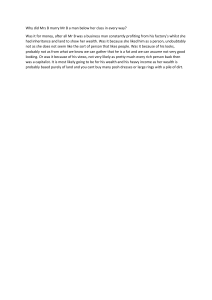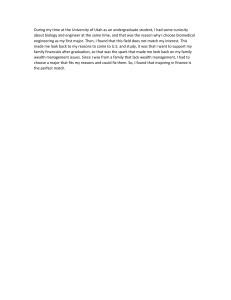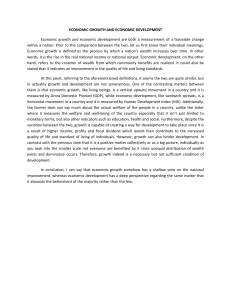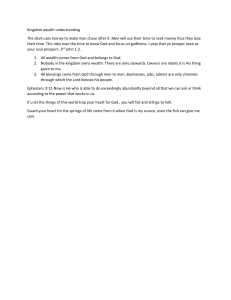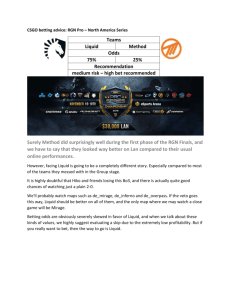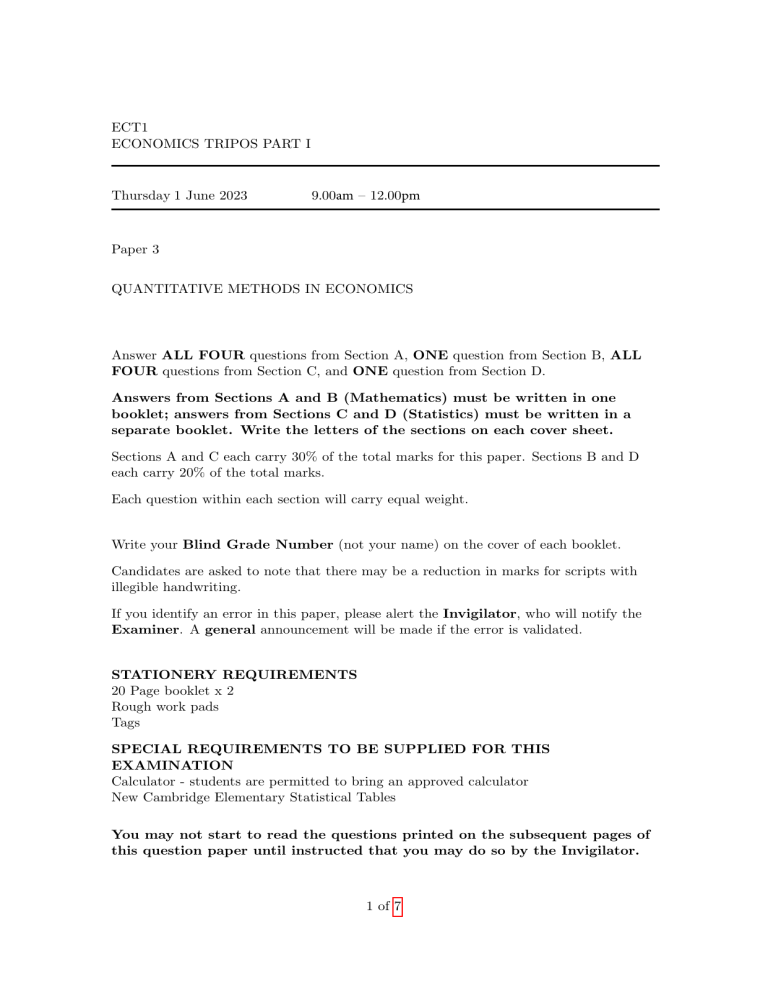
ECT1
ECONOMICS TRIPOS PART I
Thursday 1 June 2023
9.00am – 12.00pm
Paper 3
QUANTITATIVE METHODS IN ECONOMICS
Answer ALL FOUR questions from Section A, ONE question from Section B, ALL
FOUR questions from Section C, and ONE question from Section D.
Answers from Sections A and B (Mathematics) must be written in one
booklet; answers from Sections C and D (Statistics) must be written in a
separate booklet. Write the letters of the sections on each cover sheet.
Sections A and C each carry 30% of the total marks for this paper. Sections B and D
each carry 20% of the total marks.
Each question within each section will carry equal weight.
Write your Blind Grade Number (not your name) on the cover of each booklet.
Candidates are asked to note that there may be a reduction in marks for scripts with
illegible handwriting.
If you identify an error in this paper, please alert the Invigilator, who will notify the
Examiner. A general announcement will be made if the error is validated.
STATIONERY REQUIREMENTS
20 Page booklet x 2
Rough work pads
Tags
SPECIAL REQUIREMENTS TO BE SUPPLIED FOR THIS
EXAMINATION
Calculator - students are permitted to bring an approved calculator
New Cambridge Elementary Statistical Tables
You may not start to read the questions printed on the subsequent pages of
this question paper until instructed that you may do so by the Invigilator.
1 of 7
SECTION A – Answer ALL FOUR questions from this Section.
A1
A real-valued function f (x) is defined for x ∈ R as follows
(
exp(x) for x ≤ 0
f (x) =
x + 1 for x > 0
(a) Show that f (x) is differentiable everywhere, and that the derivative f 0 (x) is a
continuous function.
(b) Identify the range of function f (that is, the set of values attained by f ).
Denoting this range by D, explain why f has an inverse function g defined on
D.
(c) Derive an explicit expression for g and identify its range.
A2
Let S ⊆ R be the set of all solutions to the equation sin x = 0.
(a) Show that S is a closed set.
(b) Show that S is not a compact set.
A3
Let A be the 2 × 2 matrix obtained by multiplying the column vector a =
with its transpose a0 = 1 1 . That is
1
1
!
A = aa0 .
(a) Evaluate the matrix A10 .
(b) What geometric linear transformation does A represent?
(Hint: recall that for any 2 × 1 vector b, we have a0 b = kak kbk cos β, where β
is the angle between a and b).
A4
A profit-maximising firm’s cost function is
c(q) = q + α(1 − q)2
where q ∈ R≥0 is the amount of units produced and α is a constant greater than 12 .
The unit price of its output is p, also a constant.
(a) Show that the firm’s optimal choice of q is positive.
(b) How does the firm’s optimal profit change in response to small changes in α?
2 of 7
SECTION B – Answer ONE question from this Section.
B5
Consider a household that consists of two people, A and B. Both A and B consume
only two goods: good1 and good2 . The unit prices of both goods are equal to 1.
Person A’s utility from consuming xA units of good1 and yA units of good2 equals
uA (xA , yA ) = 3 − (xA − 10)2 − (yA − 5)2 .
Person B’s utility from consuming xB units of good1 and yB units of good2 equals
uB (xB , yB ) =
1
xB yB .
2
The income of A is 15 and the income of B is 20.
(a) Find the unconstrained maximum of function uA .
(b) Assuming A and B do not share their incomes and are both utility maximisers,
how much of each of the good will be consumed by A and by B?
(c) Suppose now that A and B pool their incomes and try to maximise the sum
of their utilities. Argue that at the optimum, all the marginal utilities (that
is, ∂uA /∂xA , ∂uA /∂yA , ∂uB /∂xB , and ∂uB /∂yB ) will be non-negative.
∗ , x∗ , y ∗ ) .
(d) In the setting of (c), find the optimal consumption bundle (x∗A , yA
B B
B6
A profit-maximising firm uses two divisible inputs, K and L, to produce a divisible
output. The firm’s resulting cost function is
C(r, w, y) = y(r +
√
rw + w)
where r and w are the unit prices of K and L, respectively, and y is the amount of
output produced.
(a) We define the firm’s technical rate of substitution (TRS) as the rate at which
it should increase one input in response to a decrease in the other input if the
firm aims to keep production constant. Evaluate the firm’s TRS when the firm
is optimising. Explain your answer.
(b) Derive a production function f (K, L) which leads to the above cost function.
3 of 7
(TURN OVER)
SECTION C – Answer ALL FOUR questions from this Section.
C7
A gambler is offered a sequence of betting opportunities where each bet has probability p of winning (and probability 1 − p of losing). Successive bets are independent
events.
With wealth W , if they choose to bet a fraction f of that wealth and if the bet wins,
then their wealth grows to (1 + bf )W ; if the bet loses, then their wealth drops to
(1 − af )W , where a and b are both positive constants.
(a) Show that if they bet the same fraction (f ) of their wealth in each round of
betting, and if they start with initial wealth 1, then the expected value of log
wealth after n gambles is
E (ln (W )) = np ln (1 + bf ) + n (1 − p) ln (1 − af )
(b) Suppose, again, that the gambler will bet a fixed fraction of their wealth in
each round of betting. Show that to maximise log wealth after n bets, the
fraction f ∗ they choose to bet in each round is given by
f∗ =
p 1−p
−
a
b
(c) A fair bet is defined as one where the expected return is zero. How much will
the gambler (who is trying to maximise expected log wealth) stake on a fair
bet? If they were to commit to betting a fixed fraction of their wealth in each
round of a sequence of bets, what fraction would they choose? Justify your
answer.
C8
My fund manager promises they will deliver an average return on investment of
0.5% per month. Over the last 60 months their actual returns have averaged 0.45%
per month with a standard deviation (expressed in the sn−1 notation) of 0.1. They
say this has just been a run of bad luck. Should I fire them for failing to maintain
their claimed performance? Justify your answer, being clear about any assumptions
you have made.
4 of 7
C9
(a) A fair coin is tossed until a head appears. If a head appears on the ith toss, a
ball is selected at random from 5i balls of which 3i are red.
i.
ii.
Find the probability that a red ball is selected.
Given that a red ball was selected, find the probability that a head first
appeared on the third toss.
(b) A biased coin is tossed repeatedly and the outcomes are independent. Each
time, the probability of heads is 25%. Evaluate the probability that it takes
exactly 36 tosses to accumulate 9 heads.
C10 A researcher interested in understanding how the weight (w) of individuals changes
over time, writes down the following regression model
wi2011 = α + βwi2004 + εi
(1)
where w2011 (respectively, w2004 ) denotes the weight (in pounds) of individuals in
2011 (respectively, 2004).
(a) Based on a sample of 500 individuals, the estimated regression equation is
presented below
w
bi2011 = 17.42 + 0.97 wi2004
(0.000)
R2 = 0.71
(2)
(0.000)
Note: p-values are in parentheses
(i) Provide an interpretation of the regression equation (2).
(ii) Test the H0 : β = 0 against a two-sided alternative.
(b) The summary statistics in Table 1 indicate that, on average, the respondents
put on 13 pounds over the period 2004-2011.
Table 1: Summary Statistics
Variable Mean Std. Dev Min Max
w2004
169.7 40.3
95
330
w2011
182.7 46.7
95
370
Using the results from (a), comment on whether this change is due to the
relatively heavy individuals becoming even heavier, or due to a general increase
in weight.
(c) What do we learn from R2 = 0.71?
(d) Show that
X
(wi − w)2 =
i
X
i
(w
bi − w)2 +
X
εb2i
(3)
i
where εb2i = (wi − w
bi )2 , and consequently derive an expression for R2 in terms
of wi2011 and wi2004 .
5 of 7
(TURN OVER)
SECTION D – Answer ONE question from this Section.
D11 You have a sample of observations {yi , xi } , i = 1, . . . , N , generated by
yi = xi β + εi
where β is an unknown parameter, xi are a set of fixed numbers, and εi are IID
random variables from a distribution with E (εi ) = 0 and E ε2i = σ 2 .
To estimate β it is proposed to use an estimator
βe =
N
X
wi y i
i=1
where the numbers wi are weights to be determined (that may depend on xi ).
e (You should give your answer in terms
(a) Calculate the bias and variance of β.
of wi , xi , β and σ 2 .)
(b) Define the mean squared error (M SE) of an estimator.
(c) Show that
M SE βe =
"
N
X
! #2
wi x i − 1 β
i=1
+
N
X
wi2 σ 2
i=1
e
(d) Show that if we impose that βe is unbiased and then minimise the M SE of β,
then we obtain as optimal weights
wi =
xi
PN
2
j=1 xj
(e) Show that to minimise the M SE of βe (with no restriction on bias), the weights
wi should now be chosen as
wi =
(f)
β 2 xi
P
2
σ2 + β 2 N
j=1 xj
Comment on the practicality of the estimator in (e) compared to that in (d).
6 of 7
D12 A variable Y depends on a nonstochastic variable X through the relationship
Yi = β1 + β2 Xi + ui
(4)
where β1 and β2 are unknown parameters; E(ui |Xi ) = 0 and Var(ui |Xi ) = σ 2 for
all i; Cov(ui , uj ) = 0 for all i 6= j.
(a) Given a sample of n observations, an analyst decides to estimate β2 using the
expression
Pn
Xi Yi
b
β2 = Pi=1
(5)
n
2
i=1 Xi
(i) Demonstrate that βb2 is in general a biased estimator of β2 .
(ii) Comment on whether it is possible to determine the sign of the bias in βb2 .
(iii) Demonstrate that βb2 is unbiased if β1 = 0 or X̄ = 0.
(b) On seeing the scatter of points on Y and X in the figure below, another analyst
attempts to estimate the slope by drawing a line connecting the first and last
observations, and dividing the increase in height by the horizontal distance.
This estimator is given by
βe2 =
Yn − Y1
Xn − X1
(6)
(i) Find an expression for the expected value of βe2 .
(ii) Which of the Gauss Markov assumptions implies the unbiasedness of βe2 ?
(c) It can be shown that the population variance of βe2 in (6) exceeds that of the
ols estimator.
In what sense does this confirm the Gauss Markov theorem?
END OF PAPER

